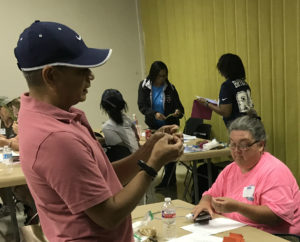Newswise — The thin, metallic lid curled as the tab was pulled across the top of a can, issuing a salty, nutty scent as almonds, Brazil nuts, cashews, hazelnuts and peanuts spilled onto a tabletop.
But they were not to eat. No, these mixed nuts were sorted and counted by teams of middle and high school teachers seeking ways to interest their students in science careers.
“It’s a cool way to show students how to calculate and do statistics,” said Evan Rawls, an eighth grade science teacher at Lumberton Middle School. “With this, we can teach the students about mean, median and mode, for example, as they compare their counts to what’s on the label.”
The exercise was but one simple, cost-effective method taught to about 40 regional science teachers at the Texas A&M AgriLife Research and Extension Center-Beaumont by Dr. Mo Way and his fellow scientists there.

Dr. Rodante Tabien, Texas A&M AgriLife Research rice breeder in Beaumont, teachers middle and high school science teachers how to cross two varieties of rice. (Texas A&M AgriLife photo).
Way — whose ordinary day as an entomologist at the research facility west of Beaumont might include walking barefoot through a flooded rice field sweeping insects into a net — has led the teacher workshop for four years. It’s an effort to teach so-called STEM courses — science, technology, engineering and mathematics — via agriculture.
The U.S. Department of Education estimated that only 16 percent of American high school seniors are proficient in math and interested in a STEM career, while the percentage of jobs in STEM-related careers is projected to be increasing by as much as 60 percent through 2020. The department also said the U.S. is “falling behind internationally, ranking 29th in math and 22nd in science among industrialized nations.”
But while many of the STEM educational efforts point to math, computer and medical science, researchers at the Beaumont station note agriculture is a common thread through all of those disciplines.
“There’s nothing more important than the production of food. We have 7 billion people in the world, and that’s expanding. The general population needs to know that what we’re doing for the community, the state, the nation and the world – how important it is,” Way said.
He also ponders retirement — his own in about three years and those of so many of his colleagues in agriculture who’ve done the largely behind-the-scenes work of developing higher yielding crops that are more resistant to pestilences.
“Who will take our place? This is one way to get kids interested in biology, the sciences and math – because they are the future entomologists, physiologists, pathologists, rice breeders,” Way said. “What we need is more students at the high school and middle school level to become interested.”
Stoking the interest for the teachers – who will convey the information in a hands-on way to their students beginning this fall – were a nature walk and several lab activities.
The nature walk incorporated math, for instance, by using a measuring wheel with a 6.6-foot circumference to calculate distance. Along the mile-long walk, the scientists pointed out fields of conventional rice, organic rice, soybeans, sugarcane and sorghum, as well as aquatic and terrestrial insects, and many species of weeds and birds.
“In fact, we found some Johnsongrass that was infested with sugarcane aphids, so we collected some to view under the microscope,” Way said. “And we talked about the life history of the sugarcane aphid and how it attacks crops.”
Back indoors, the teachers measured the contents of cans of mixed nuts to determine the percent of each type, then compared the results to the label. This demonstrated the method for developing data sets and the need for replications of research experiments, Way said.
The teachers also were taught by AgriLife Research-Beaumont rice breeder Dr. Rodante Tabien how to cross two varieties of rice by manipulating the plants’ flowers.
Way sent each teacher home with some rice seed and instructions on how to grow it.
“Teachers have a big impact on kids and what direction they are going to go in the future,” Way said, recalling his own high school biology teacher who taught by letting his classes experience trips to a garden or collecting wildflowers to press and identify. “Some of the teachers told me that their students are urban kids, so they don’t know where bread comes from. Our society needs to become more educated about science issues because it’s becoming so important.”
Rawls said when he conveys what he learned to his students, they are likely to be interested in pursuing careers in agricultural science.
“Being from Lumberton, they are aware of agriculture, but this will help show them some of the opportunities,” Rawls said. “Otherwise, they might pursue careers in industry, which is fine. But it’s good to show them there are other opportunities, and in agriculture there are ways to make a good living in jobs they didn’t even know existed. The research here at the Beaumont center affects the world, and they can be a part of that.”
-30-